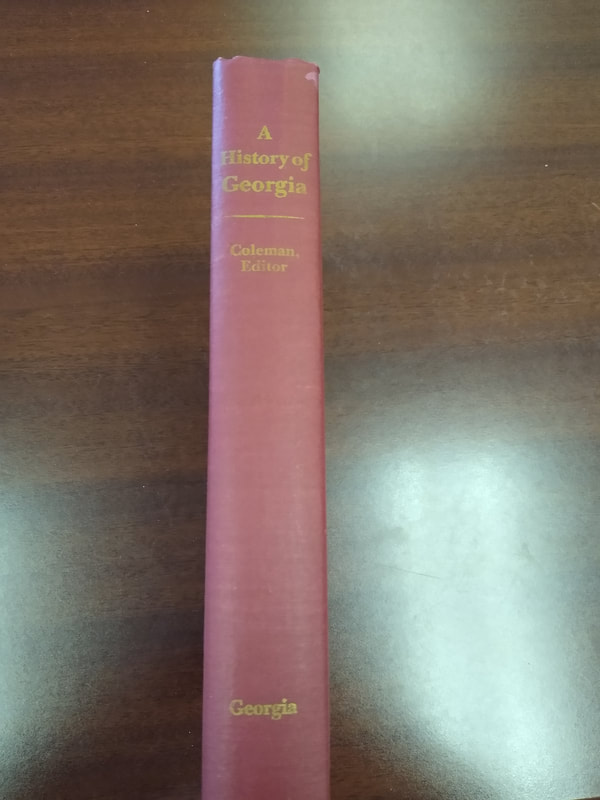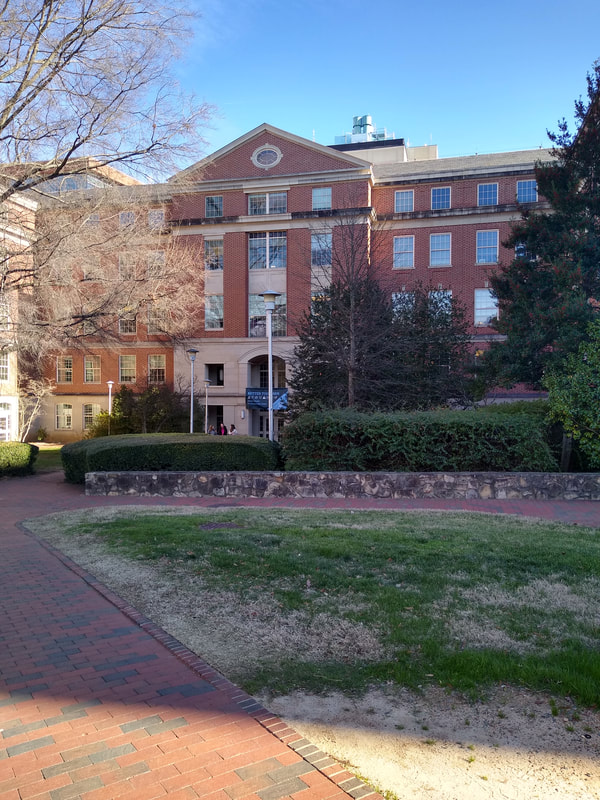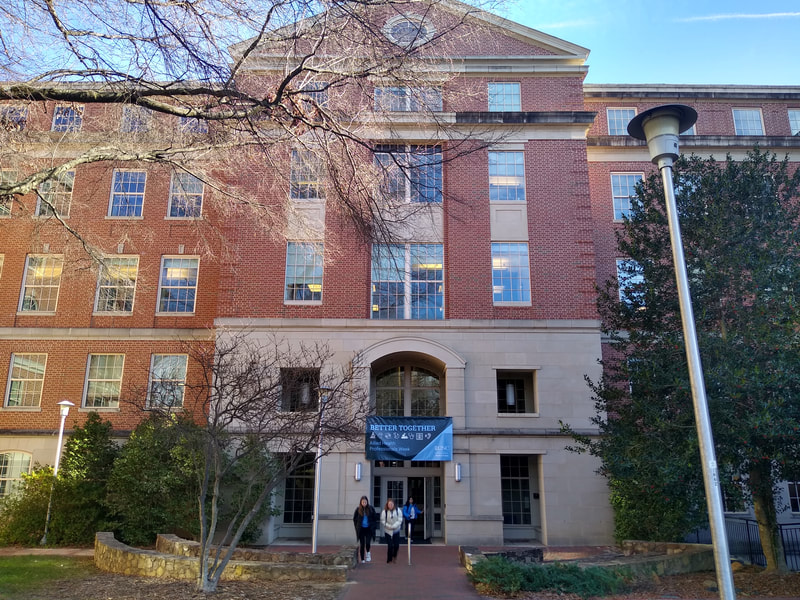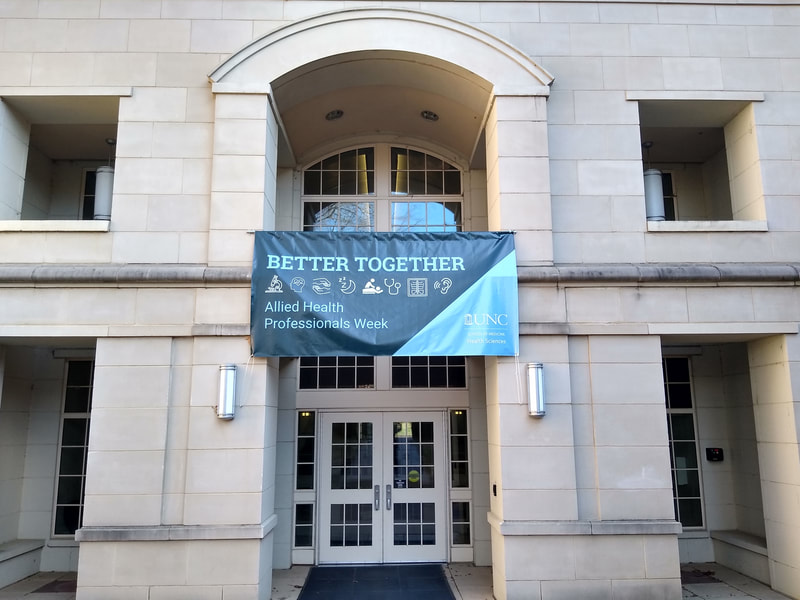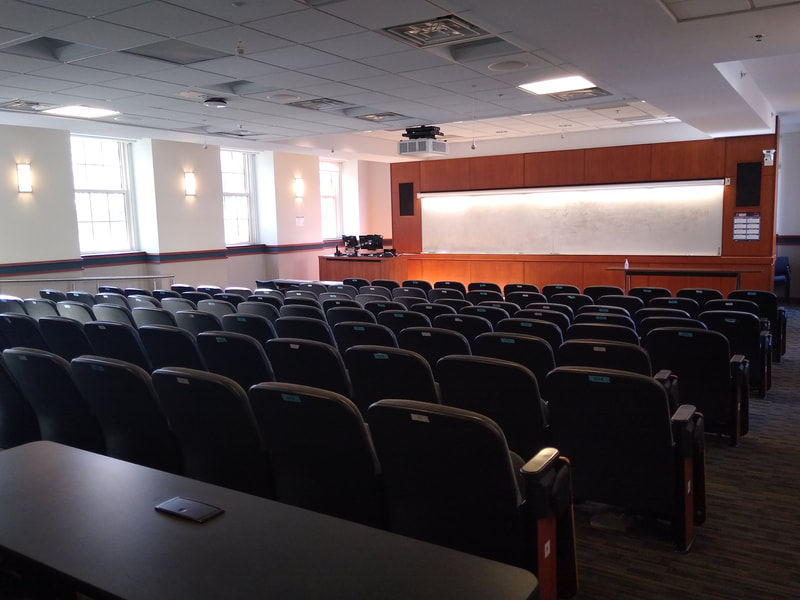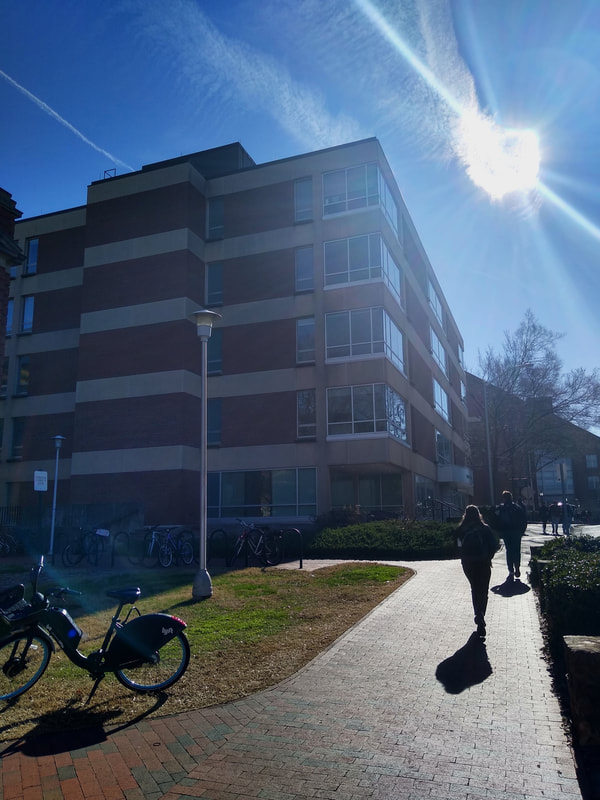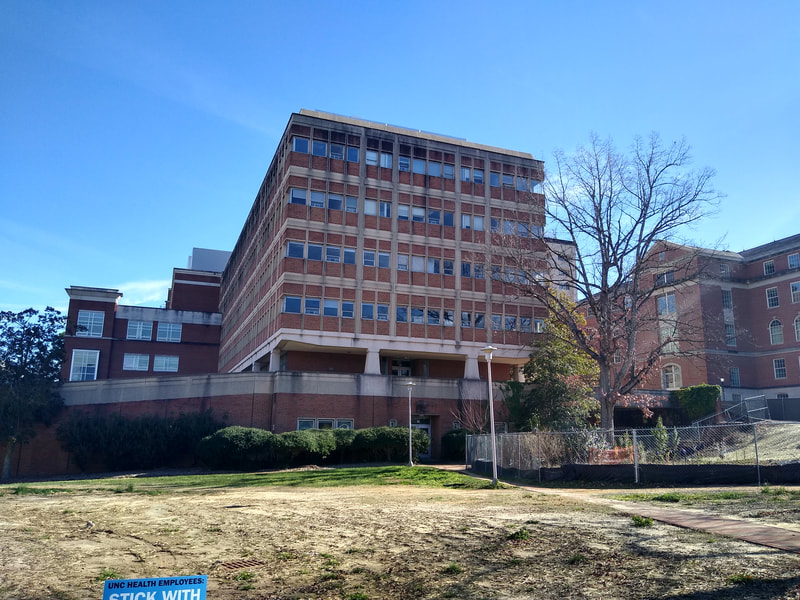University Grounds
Menu
University grounds
|
I have often remarked that the academy is a very small world. If you have been in higher education for any length of time, you will quickly realize that you have connections to people everywhere. Today, I found I had an unexpected connection to someone in higher ed via a book. As the pandemic ended and things were beginning to go back to normal on campus, I happened across a fellow professor here on campus who was cleaning out his office. He was leaving the university and divesting himself of a variety of books he had collected along the way. We struck up a conversation and realized that we shared an interest in history. He gave me a book on the history of Georgia. I have thumbed through it, but only just today realized that he had inherited the book at some point. The original owner had placed his name inside the cover – Guy Bailey. I don’t know Dr. Bailey personally, although we have a few things in common. He completed his Ph.D. in English Linguistics from the University of Tennessee in 1979. I would follow him there by just over a decade, eventually completing my undergraduate and master’s studies at UT in 1992 and 1994 respectively. While I was there, he became Chair of the Department of English at the University of Memphis in 1993. I came to the UofM in 2016 to be Chair of the Department of Counseling, Educational Psychology and Research. In between, I went to Texas Tech to complete my Ph.D. He would follow me there, albeit at a very different level! He was President of Texas Tech from 2008-2012. Fate would have it that two guys who have never met but who have been at three of the same institutions would come to have the exact same book. Small world indeed!
0 Comments
We have just come out of some snowy and very cold weather here in the metro Memphis area. Local schools and the University of Memphis were closed all week as a result. On one of those days, I had the opportunity to leave the snow behind and head over to North Carolina. I was in Chapel Hill and it was both warmer and sunny during my visit. My visit did not allow much free time, so despite being on one of the most storied public university campuses in the nation with some great weather at hand, I was unable to take a proper tour or get many photos. I was visiting the School of Medicine there, and had only a few minutes to take a quick stroll in the vicinity of the various health sciences buildings. Thus, in today's post you will unfortunately not see some of the iconic structures across what is a lovely campus. First up, we have Bondurant Hall. They were celebrating Allied Health week during my visit, hence the banner above the front door in the first four photos. Bondurant opened in 1962 but owing to its appearance you might not realize that at first glance. You also might not be able to tell that from the inside. The building opened with the name Medical Sciences Research Building, or MSRB. It began its life as the first school of medicine building dedicated primarily to research. Its construction was approved in 1959, and the 55,000 square foot building came with a price tag of $1.5 million (or about $15.6 million in early 2024 value). It would receive its current name in 1995, when it was rebranded in honor of UNC alumnus (Class of 1949) and former Dean of the School of Medicine, Dr. Stuart Bondurant. After finishing his studies at Chapel Hill, Bondurant would make the short trip to Durham for medical school, graduating from Duke in 1953. He spent time in the Air Force in the Aerospace Medical Lab at Wright-Patterson Air Force Base in Dayton, OH. After being discharged, he did a fellowship in cardiology at Peter Bent Brigham Hospital in Boston. He would soon make a name for himself in cardiology and academic medicine. After his fellowship, he joined the faculty of the School of Medicine at Indiana University in 1959 where he stayed for six years. After a year at NIH, he moved to take the position of Chair of the Department of Medicine at Albany Medical College in New York. He became dean there in 1974. Bondurant returned to Chapel Hill as dean in 1979. He oversaw many changes at the School of Medicine during his time as dean at Chapel Hill. He added five new departments, including the Department of Physical Medicine and Rehabilitation (PM&R). I was in the PM&R department in the School of Medicine at Virginia Commonwealth University, and we watched the workings at Chapel Hill closely. He stepped down as dean in 1994 but remained on faculty until 2004. Along the way, he was elected to the Institute of Medicine in 1979, elected president of the American College of Physicians in 1980, and named Fellow of the American Association for the Advancement of Science in 1982. He received honorary doctorates from Indiana University (1980) and Georgetown University (2000). He passed away on May 26, 2018. Bondurant Hall was greatly renovated and expanded in 2003 under the leadership of the then School of Medicine Dean Dr. William L. Roper. The renovation and addition nearly doubled the size of the building to 106,000 square feet. Upon the renovation's completion, the space was converted to classroom and office space. Until 2023, it was the home of the dean’s office and supporting units which subsequently moved to the new Roper Hall when it opened (see below). The building is connected to the much older MacNider Hall, built in 1932. Indeed, the 2003 renovation saw the façade take a new look to better match the look of MacNider. The Raleigh-based Brown Jurkowski Architects Collaborative (BJAC) did the design work for the renovation and addition. The main entrance, seen in the first four photos, is on the western side of the building. I wanted to give some idea as to what the inside looked like without getting a bunch of people in the photo, so I took a picture of the Dr. and Mrs. Williamson B. Strum Auditorium while it was unoccupied. Seen in the last two photos, the auditorium shows a classroom that is as modern, clean, and comfortable as is the rest of the building. Next, we have a photo of the Health Sciences Library. Regrettably, it is not the best picture. My brief time for exploration had expired and I was hurrying back to meet with people from the School of Medicine. The sun was in my face, and I paused and took several photos in quick succession. This was, believe it or not, the best one of the bunch. If I had more photos of campus to share, I would not have included this one, but since I had taken so few, I decided to upload it. The library traces its roots back to a donation of medical books to the university in 1801. Major General Calvin Jones, a North Carolina physician, gave a collection of books the UNC that year, a full 78 years before medical instruction would come to campus. For years, medical books were housed in Smith Hall, although medical journals were kept in Person Hall, the home of the medical school. When the school moved into Caldwell Hall in 1912, the entire collection, books included, were relocated there. In the 1890’s, the School of Pharmacy developed its own library. The entirety of the book collection was donated. The pharmacy library’s entire budget in 1897 was spent on the acquisition of one journal! The collection followed the movement of the school from Venable to Howell and then on to Beard before joining the health sciences library as a whole. The School of Public Health also maintained its own collection and followed its own weaving path to a unified library. Finally, in 1939 the medical library hired its first dedicated professional librarian, Agnes Dolvin. Dolvin was trained in the library program at Columbia and joined the staff when the library was located in MacNider Hall. When the School of Nursing began in the 1950’s, its collection was technically a component of the medical library despite it being housed in the Nurses’ Residence. Back in 1952, the university hired Myrl Ebert as the director of the Health Sciences Library. One of the things she did was to change the call number system. There are various ways to assign call numbers to books. Most collegiate libraries use the Library of Congress Classification System. Such is the case with the library here at the University of Memphis where I currently work. Many public libraries use the Dewey Decimal Classification (frequently called the Dewey Decimal System). Even prior to going to college, I was not a big fan of the Dewey System for a variety of reasons too specific for a blog post, but suffice it say that I much prefer the Library of Congress Classification. I’m not sure what classification system the UNC libraries were using prior to the change, but Ebert moved the Health Sciences Library to the National Library of Medicine Schedule classification scheme. I was on the Medical College of Virginia campus (i.e., the health sciences campus) of the Virgina Commonwealth University for many years and it has its own library. It may have used the National Library of Medicine Schedule at some point, but it was on the Library of Congress system when I arrived there in 2001. The only library I have frequented that used the National Library of Medicine Schedule was the Texas Tech Health Sciences Center Library. It makes sense when I think about it. The health sciences at Texas Tech are contained in two independent universities: the Texas Tech Health Sciences Center Lubbock, and the Texas Tech Health Sciences Center El Paso. The library of TTUHSC is not connected to the libraries of the main campus of Texas Tech. As such, there is no reason for the collections to use the same indexing system. At VCU, the health sciences sit on their own campus, but are part of a singular institution with a unified library across locations. Hence it makes sense that they would have the same indexing system. UNC is unique in that respect, at least to me. The health sciences schools are part of the larger university. I would think that would have the various libraries on the UNC campus using the same system, but that is not the case. Oh, the things academic nerds like me think about! Ebert ran the library until 1975, leading the library through a substantial growth period culminating with the creation of the building you see in this photo. The current library opened in 1970 and that was the first time the various collections from the health sciences schools on campus were housed together in a combined facility. Well, that is with one notable exception. The pharmacy library would not merge with the other health sciences until 1979. The space the library occupies was once a courtyard for MacNider Hall. Owing in part to the combining of the various health sciences libraries and to the growth of all the collections during her twenty-two years as librarian, Ebert saw the number of volumes grow from around 36,000 to just over 140,000. The number of journal subscriptions more than tripled, and the budget grew about 800%. When the building opened in 1970, it looked similar to how it appears today. Actually, the first two floors are exactly the same. An addition which opened in 1982 added the final three floors you see today. The photo below is the new Roper Hall, home to the School of Medicine's dean's office. In addition to the dean’s offices, it has classrooms, a cafe, study rooms, the school’s student affairs offices, simulation labs, and a variety of other learning spaces. I am not sure if the construction fence you see on the left in this photo is associated with the construction of Roper or to perhaps to some work going on in Carrington Hall (see below). The building is named after William "Bill" L. Roper, former dean of the UNC School of Public Health (1997 to 2004). In addition to the dean’s offices, it has classrooms, a cafe, study rooms, the school’s student affairs offices, simulation labs, and a variety of other learning spaces. In terms of the teaching and support space, the building is a replacement for Berryhill Hall which served the same purpose and was in the exact same location. Berryhill was not that old of a structure, having opened in 1970 (the same year I was born), but in the landlocked area of campus where the health sciences are located the university decided it was best to raze that structure and build a new one. Part of the funding for Roper came from a bond issued in 2016 for $68 million. The building comes in at 172,000 square feet across its six floors. Construction began in May 2020 and proceeded rather quickly by today’s standards. A topping out ceremony was held on November 15, 2021, and the building was officially opened in an event on September 18, 2023. It had already opened for business with classes commencing weeks earlier. Roper was designed by Flad architects and the S/L/A/M Collaborative. Flad had previously worked on the Koury Oral Health Sciences Building at UNC. They have also designed buildings at nearby North Carolina State University, Northwestern University, Rutgers, and the University of Wisconsin Madison. Readers may remember that they designed the Translational Research building at the University of Mississippi Medical Center I covered in an earlier blog post. S/L/A/M Collaborative has designed numerous collegiate structures across the country including works at Georgia Southern University, Rutgers, the University of California, Irvine, the University of Iowa, and the University of Tennessee, Knoxville among others. The School of Medicine has come a long way over the years. The medical school began, as was common at the time, as something very different than what it is today. If you’ve read my earlier posts on medical schools at Saint Louis University, the University of Mississippi Medical Center, and the University of West Tennessee you will recall that until the 20th Century, many (perhaps most) medical schools in the U.S. were two-year programs. What you might not realize is that prior to the 20th Century, they were sometimes less than that. Indeed, many programs were less than two years in duration, and not only were students not required to have a bachelor's degree, but they also frequently had no undergraduate training at all. In some cases, particularly with the small proprietary schools which dominated the landscape, applicants did not even need the equivalent of a high school diploma. Although connected with an accredited institution of higher learning, the medical school at UNC had some of these features when it started. Dr. Thomas W. Harris, an alumnus of the university (Class of 1859), was a practicing physician in Chapel Hill when he was asked by officials at the university to start a medical program. He agreed, and along with two other faculty members would start the program in 1879. Interestingly, although associated with the university, it was not really part of the college. It was something of a contractual relationship. In 1890, Richard H. Whitehead, a graduate of the medical school at the University of Virginia, was recruited to Chapel Hill to take the reins and run the program. He would stay in the position until 1905 when he returned to Charlottesville to take the dean’s position at his alma mater. Mr. Jefferson’s university and North Carolina compete for prominence in both sports and academics, and although I’m sure his contemporaries wished him well there may have been some quietly made remarks about his going to Virginia. Today, the medical schools at Virginia and North Carolina are both considered top notch, although UNC consistently outranks its peers in Charlottesville. Prior to 1905, the medical curriculum was very old school. A step toward modernization came just as Whitehead departed to Virginia when the program went to a full two-year system. Isaac Manning had followed Whitehead as dean and it was under his direction that the program went to the full two-year format, joined the Association of American Medical Colleges, and was a full-fledged component of the university. UNC would not move to a four-year standard until 1954 and when it did it was initially not in Chapel Hill. The four-year program was initially located in Raleigh owing in part to the size of the local population which was significantly larger than that of Chapel Hill and to the fact that it was the home to state government. This would not last and the program at Chapel Hill would be the eventual home to the four-year program. Today, the School of Medicine is consistently ranked in the top five for public schools in terms of research. The UNC health system is known worldwide and is a massive operation with revenues well into the billions. It is amazing how much has come so quickly. The photo below is the original portion of Carrington Hall, home of the School of Nursing. The building is named for Elizabeth Scott Carrington. Carrington, a North Carolina native, completed her BSN at the University of Pennsylvania (Class of 1926). She stayed on at Penn in a clinical capacity where she also continued her education. She earned her master’s in nursing there in 1940. She returned to North Carolina in 1941. She married George Lunsford Carrington, a graduate of the two-year medical school at UNC (I could not find out when he completed the program). It was thanks in large part to her advocacy and hard work that the UNC nursing program came into being as a four-year degree program and subsequently earned its first accreditation. The building opened in 1969 and would be expanded with a significant addition in 2005 which more than doubled its original size. You can see a great photo of Elizabeth Carrington from what I imagine is either the late 1960’s or early 1970’s (possibly around the time of the building’s opening) here. If you recognize her maiden name, it is because the Scott family has deep roots in North Carolina. They have included state representatives, a U.S. Senator, business people, and a variety of government officials. Indeed, Scott Hall at nearby North Carolina State University is named for Robert W. “Farmer Bob” Scott. You can read more about the family here. Her nephew was North Carolina Governor Robert W. Scott (son of “Farmer Bob” Scott). In 1971, she and Governor Scott would donate 48 acres for the establishment of the Technical Institute of Alamance (now Alamance Community College) in her hometown. Today, the campus is known as the Carrington-Scott Campus. The two photos below are of Beard Hall and Kerr Hall, the home to the School of Pharmacy. The School of Pharmacy was initially founded by Thomas W. Harris in 1880. This was just one year after the founding of the school of medicine. When Harris left the university in 1886, the school was shuttered. An attempt by Richard Whitehead to revive the program 1889 was also brief and the program was closed again owing to a lack of students. It was brought back under President Alderman in the spring of 1897. Alderman hired Edward Vernon Howell to run the program. Howell, a graduate of Wake Forest and the Philadelphia College of Pharmacy, was running his own drug store in Rocky Mount, NC. He would remain at UNC for the rest of his career. In the early part of his career, he did something that was common at the time, but which is now unimaginable: he was a member of the UNC Tar Heels football team! Faculty played football at numerous institutions in the 1800’s side by side with students. He had played as a student at Wake Forest, and when he came to Chapel Hill, he once again donned his cleats and hit the grid iron, playing left halfback. He was on the undefeated 1898 team. He passed away during his time as dean in 1931. Howell was followed by John Grover Beard. Beard graduated from the school in 1909 and immediately joined the faculty as an instructor. He rose to assistant, associate, and (full) professor by the time of his appointment as dean in 1931.
Pharmacy had previously been housed on the first floor of New West Hall and then, in 1912, to Person Hall. During Howell’s time, pharmacy had moved into the former chemistry building which had been opened in 1906. The school had relocated to the building in 1925 as chemistry had moved to the then new Venable Hall in 1924. Interestingly, at least by today’s standards, the building was named for Howell while he was still a sitting dean. Although it was an improvement which allowed the school to have its own home, it was quickly outgrown. A replacement would not be easily acquired. By 1943, then dean Beard was making frequent formal requests for additional space. By 1949, the school had so outgrown the space in Howell that they had reduced admissions despite a shortage of pharmacists in the state and the need for such professionals for the war effort. Some classes had been held in the botany department’s space for a time as there was no room left in the building. Howell was not only too small for the purpose, it also lacked much of what a then modern school of pharmacy required in terms of equipment and facilities. By the 1950’s, pharmacy was denying admission to 40% of applicants simply due to the lack of space. Grumbling could be heard from pharmacists across the state when their children were not admitted despite legacy status and generally good credentials. State support finally came in 1956 with an appropriation for the initial design work for a brand-new building. A groundbreaking ceremony for the building, designed by the Holloway-Reaves architectural firm from Raleigh, was held on May 27, 1958. It was completed not quite two years later in November 1959 and was formally dedicated on April 24, 1960. Classes were moved into the building immediately. It was named in Beard's honor. Kerr Hall came about thanks in part to the growth of the student population. When Beard Hall opened, the school enrolled 240 undergraduate students; by 1993 there were 494. The number of faculty had grown as well from eight in 1960 to 55 in 1993. The school was tearing at the seams of Beard Hall which was also showing some signs of age. The solution was to renovate the existing space in Beard and build an addition which was initially to be called the Beard Hall Annex. Fund raising began in earnest in 1994. The 65,000 square feet annex would come at a cost in excess of $18.2 million (more than $37.8 million in 2024 value). Delays in acquiring the necessary funding pushed back construction. The groundbreaking was not held until October 12, 1998, and it would not open until 2002. It was named in honor of Banks Kerr (Class of 1943) who went on to found the Kerr Drug Store chain. Kerr donated $2 million to aid in the construction of the building. The first photo below is a full on shot of the front of Beard. The second, a distant shot taken from beside Carrington and Bondurant, shows Kerr on the left. Again, I am not certain as to what the construction fence seen in the second photo was about. |
AboutUniversity Grounds is a blog about college and university campuses, their buildings and grounds, and the people who live and work on them. Archives
May 2024
Australia
Victoria University of Melbourne Great Britain Glasgow College of Art University of Glasgow United States Alabama University of Alabama in Huntsville Arkansas Arkansas State University Mid-South California California State University, Fresno University of California, Irvine (1999) Colorado Illiff School of Theology University of Denver Indiana Indiana U Southeast Graduate Center Kentucky Murray State University Mississippi Blue Mountain College Millsaps College Mississippi Industrial College Mississippi State University Mississippi University for Women Northwest Mississippi CC Rust College University of Mississippi U of Mississippi Medical Center Missouri Barnes Jewish College Goldfarb SON Fontbonne University Saint Louis University Montana Montana State University North Carolina NC State University Bell Tower University of North Carolina Chapel Hill Tennessee Baptist Health Sciences University College of Oak Ridge Freed-Hardeman University Jackson State Community College Lane College Memphis College of Art Rhodes College Southern College of Optometry Southwest Tennessee CC Union Ave Southwest Tennessee CC Macon Cove Union University University of Memphis University of Memphis Park Ave University of Memphis, Lambuth University of Tennessee HSC University of West Tennessee Texas Texas Tech University UTSA Downtown Utah University of Utah Westminster College Virginia Virginia Tech |
